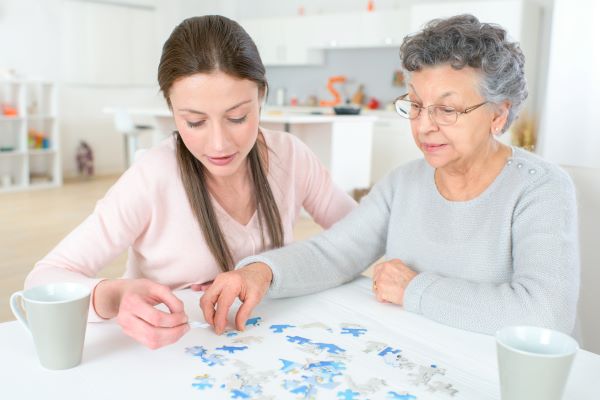There may come a day when you need assisted care. It is not comfortable to…

Alzheimer’s Patients and Memory Care Living
Approximately two-thirds of all diagnosed cases of dementia are suffering from Alzheimer’s disease according to reports published by The National Institute of Health (NIH) Library of Medicine. Alzheimer’s is also one of the most expensive diseases to treat and often results in financial strain on families trying to find and pay for the best care. In the past, care in facilities often resulted in Alzheimer’s patients being separated from others. However, as you’ll read below, facilities are now exploring better ways to treat Alzheimer’s patients while living in a facility.
Medical breakthroughs that increase our understanding of how to best treat and introduce disease modification therapies for people living with Alzheimer’s and other neurodegenerative diseases provide future hope. However, according to the Alzheimer’s Association, there are already more than 5.8 million Americans living with Alzheimer’s disease. These individuals may not live long enough to benefit from new therapy discoveries since new treatments must undergo rigorous testing and clinical trial phases. Current projections indicate that unless some of these medical breakthroughs have practical applications very soon, more than 14 million Americans will be clinically diagnosed to be living with Alzheimer’s by 2050, with many more struggling in the long-preclinical phase of the disease.
As senior living facilities become more saturated with dementia patients in all stages of progression, there is a shift underway towards non-segregated memory care living. Alzheimer’s patient reintegration into general senior living residence status is shifting dementia care into a human-centric model. It provides insights and lessons into eldercare facility living, its providers and staff, family members of residents, and all of the patients, not just memory care patients. This human-based approach is a kinder, more medically practical and appropriate, and in the long term, a more cost-effective method for facility residents who have dementia.
Before there were outcome-based clinical research findings to support the segregating of dementia patients care facilities began creating stand-alone memory care units, floors, and facilities. Families knew their loved ones were safely locked away in a highly monitored unit, and staff could focus their training and efforts on a more specified range of care. Because this isolation model became overwhelmingly profitable for business operators, it became the de facto standard of memory care operation. Profits were trumping the human condition. At the outset, it seemed rational enough to put like-patients together, yet because everyone’s memory disease progression is unique, the concept was flawed. Living circumstances for humans is an emotional experience, and the sad outcome for assembled memory care patients was faster disease progression in their isolated, shrinking worlds. This accelerated mental decline was partially due to the lack of broader social and emotional connection with non-dementia residents. It seems integrating patients of all types and generations enriches and expands what residents can do, creating a diverse human model focusing on the positive aspects of life and personal interaction.
Some of the conditions all aging adults share, not just those living with dementia, include difficulty hearing and seeing, finding mental focus more demanding, becoming more concerned about being in large crowds, and noises that increase their stress levels. For a community of residents, no matter what the patient illness, facilities can create an atmosphere that addresses these common concerns. These shared needs include not only medical care but activities that are available in a 24-hour cycle and the encouragement of socialization in smaller, quieter circles. Interactions among residents in this calming style of environment tend to create friendships organically and provide enriching connections among patients irrespective of their illness type. The overall common conditions of aging require sameness in approach, no matter how varied the residents’ medical conditions are.
Technology that allows for digital wrist monitoring of patient location and vital signs permits ease of monitoring residents, particularly as they wander their living space. Even the proper lighting, carpeting, and circular hallway architecture reassure residents’ feelings of safety, comfort, and familiarity, which appeals to all, regardless of diagnosis. When an entire senior living facility is dementia friendly, and all staff is trained in memory illness and care, every employee can add value to a resident’s enjoyment of life from the medical professionals to the social workers to the landscapers.
A diagnosis of Alzheimer’s can strike fear and worry in America’s aging population because of the emotional, physical, and financial upheaval associated with it. An older person might recognize the onset of some memory problems and become terrified, thinking about Alzheimer’s and the possibility of being relocated from their home and community to a dementia unit. There is a sense of dread that you may never feel seen, heard, and loved again by other people. Interpersonal relationships and connectedness are a hallmark of the aging communities in America. AARP reports large percentages of technology use in older Americans are related to interpersonal connections like email, viewing photos of family and friends, and using social media and the internet. Even in digital spaces and experiences, elderly community residents are looking to create personal networks, connecting to the world at large. The human spirit inclines to be expansive.
Appropriate social and physical environments play a significant role in healthy aging. Compartmentalizing memory care patients into homogeneous units will increase their memory decline, isolate their human connection, and spiral the patient into an ever-shrinking world of interaction, often making them non-verbal. Alzheimer’s patients who experience higher levels of social integration respond conversely, expanding their horizons as they experience and feel the extension of human love and support. There is no one set of symptoms for Alzheimer’s patients, and all patients are on their own trajectory of the disease. Mistakenly putting them together in a one size fits all approach of care has been a disservice to their health and well-being and to the future care of others who will become afflicted with Alzheimer’s. The memory care model is shifting for the better and not a moment too soon.
We help families who have a loved one with dementia. We explore possible sources to help pay for care, like Medicaid, and we make sure our client’s wishes are stated in properly drafted legal documents. If you have a loved one with dementia, give us a call, and let’s work on a plan to ensure your loved one has the best care possible, and their home and savings are protected. If you’d like to discuss your particular situation, please contact our Sherwood or Searcy office at 501-834-2070 to discuss how we can help you or your loved one.



